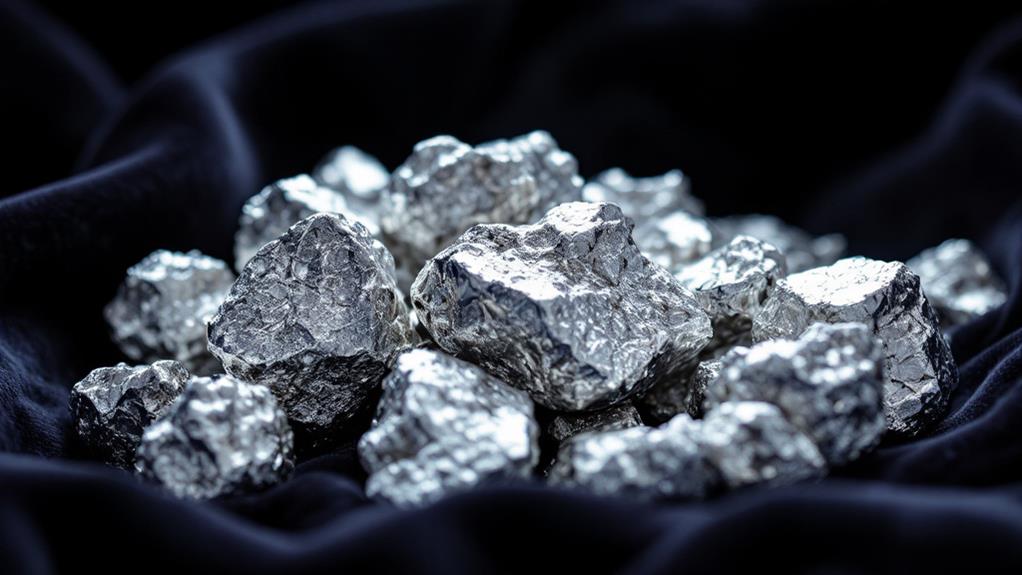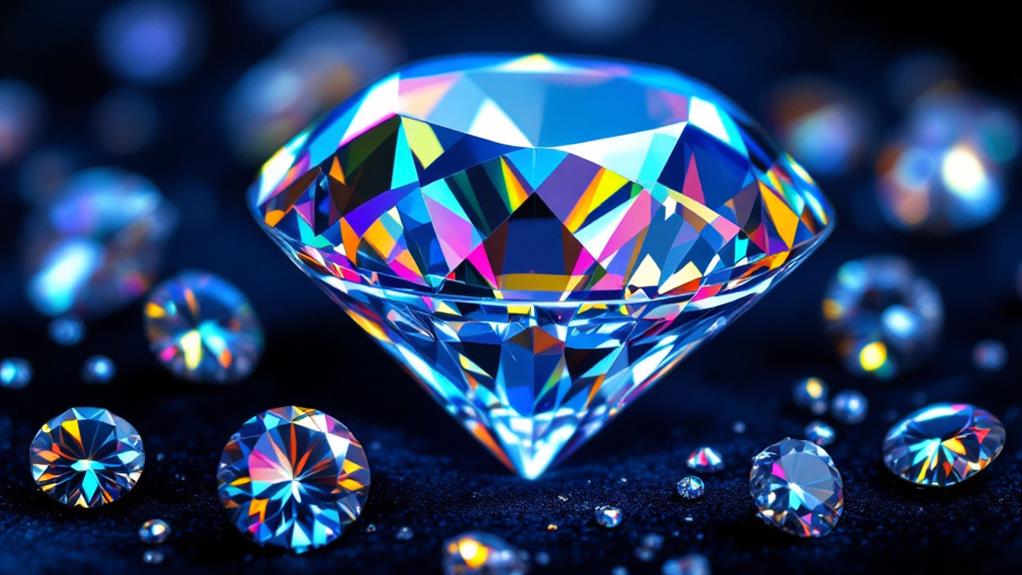Interesting Facts About Gold: The Timeless Precious Metal
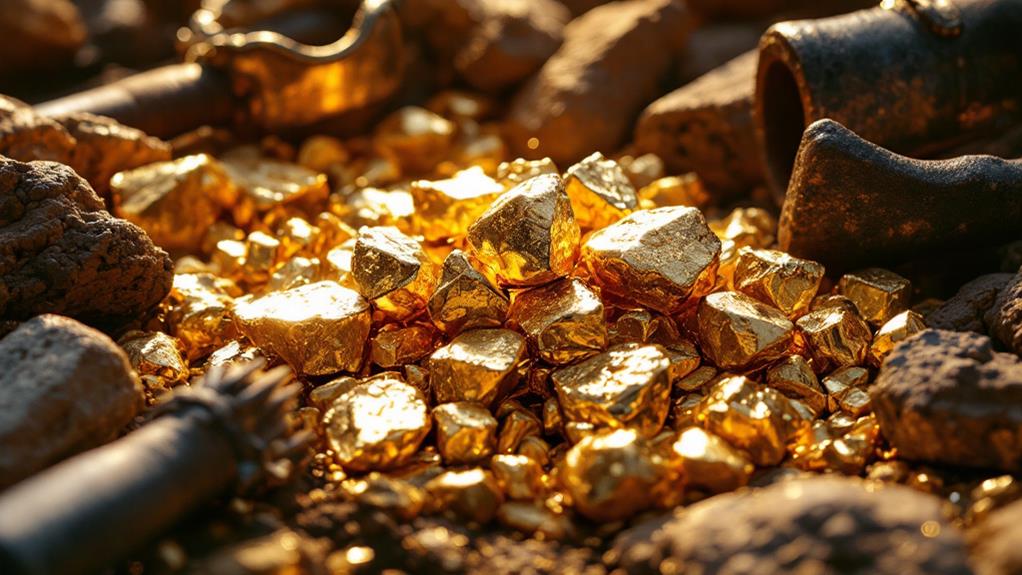
Gold is a timeless metal with cosmic origins from supernovae and meteorite storms that scattered it into Earth's crust, making it rare with just 0.003 parts per million. Even today, vast amounts remain untapped in Earth's mantle and oceans. It's the most malleable and ductile metal, capable of being pounded into thin sheets or stretched into long wires. Gold never tarnishes, making it ideal for jewelry, and its excellent conductivity finds use in electronics and aerospace. Beyond its beauty, gold serves as a symbol of wealth and is safe to eat in gourmet dishes. There's much more to uncover about this precious metal's allure.
Cosmic Origins of Gold
Gold's voyage to Earth is nothing short of cosmic. Imagine gold, along with other precious metals, traveling through the universe, birthed from cataclysmic events like supernovae. These stellar explosions scatter elements throughout space, eventually making their way to our planet. Over two billion years ago, meteorite storms, born from collisions of exotic stars, rained down on Earth. This celestial bombardment deposited gold into the Earth's crust, embedding it into the very fabric of our world.
Gold's cosmic origins emphasize its rarity. It's fascinating to think that gold makes up a mere 0.003 parts per million of the Earth's crust. This scarcity only adds to its allure, making it a highly valued precious metal. Despite being scattered across the planet, some believe vast quantities still lie hidden within the Earth's mantle and even in the oceans, although extraction remains impractical due to its low concentration.
The expedition of gold from the spectacular death throes of stars to becoming a symbol of wealth and beauty on Earth is a reflection of its enduring mystique. You can't help but marvel at how these cosmic origins contribute to gold's timeless appeal and value.
Earth's Gold Reserves
Amidst Earth's vast mineral wealth, gold reserves represent both historical accumulation and future potential. Humans have mined about 180,000 metric tons of gold, yet approximately 57,000 metric tons remain in global reserves, signaling a rich opportunity for ongoing exploration. This precious metal, constituting about 0.003 parts per million of Earth's crust, underscores its rarity and immense value. You might find it fascinating that only 20% of Earth's gold has been mined, leaving significant room for future extraction.
In terms of national holdings, the United States leads with about 8,133 metric tons of gold reserves, highlighting its strategic importance and economic influence. Meanwhile, the International Monetary Fund holds around 2,814.1 metric tons, ranking third globally. These entities understand the enduring value of gold, not just as a financial safeguard but also as a critical asset for future economic stability.
Considering the current state of Earth's gold reserves, you can appreciate the delicate balance between tapping into these resources and preserving them for future generations. The potential of what's left in Earth's crust remains both a challenge and an opportunity, inviting deeper exploration and groundbreaking mining techniques.
Properties of Noble Gold
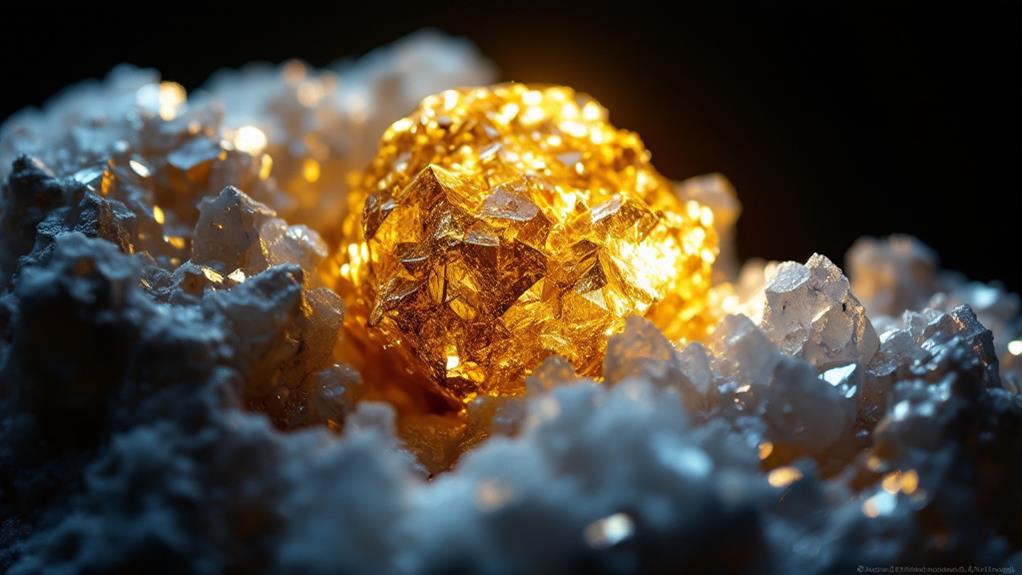
When you think of noble gold, its unrivaled resistance to corrosion and tarnishing likely comes to mind. Gold is one of the few metals that remains stable in air, moisture, and even acidic conditions, making it perfect for long-lasting applications. It's no wonder gold is often used in jewelry, where its beauty and durability shine without fading. The properties of noble gold make it a standout, requiring the powerful mix of hydrochloric and nitric acids, known as aqua regia, to dissolve it.
Gold's melting point is 1,064.43°C (1,947.97°F), and its density of 19.3 g/cm³ classifies it among the heaviest metals. This contributes to its substantial feel and unique physical characteristics. When considering gold purity, 24-karat gold represents the pinnacle, being 99.99% pure. This high purity level is the standard for premium jewelry, ensuring both quality and value.
Gold's incredible malleability lets you stretch an ounce into a sheet covering 300 square feet or a wire extending 50 miles. According to the World Gold Council, these traits make gold indispensable in industries beyond jewelry. Even in the world of paper money, gold nuggets symbolize wealth and security.
Edible Gold Uses
Edible gold adds a luxurious touch to gourmet dishes, desserts, and beverages, often in the form of gold leaf or flakes. It's a favorite among chefs looking to improve their culinary creations with a dazzling luxury appeal. Gold leaf, available in ultra-thin sheets as light as 0.12 microns, is safe for consumption, though it doesn't alter the taste of your food. Instead, it offers a visual elegance that speaks of sophistication and exclusivity.
In different parts of Asia, especially in Japan and India, edible gold has been a traditional ingredient for centuries. It's commonly used in festive foods and drinks, symbolizing wealth and prosperity. You'll find it adorning chocolates, cakes, and drinks, adding not just a sparkle but also a cultural significance that ties culinary art to history and tradition.
However, while edible gold is safe in small quantities, excessive consumption can be harmful. That's why regulations exist to guarantee it's used appropriately in food products. They protect both consumers and the integrity of this precious metal's culinary application, making sure you can enjoy its beauty without worry. So, indulge in moderation, and let gold amplify your dining experience.
Ductility and Malleability
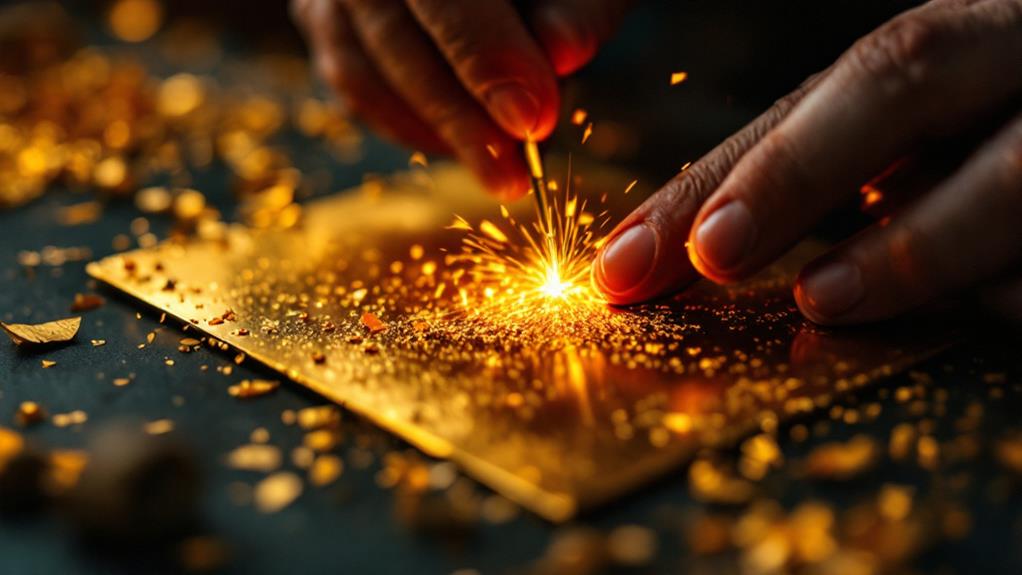
Gold's unique combination of ductility and malleability makes it a standout among metals, earning it a prized place in both industrial and artistic applications. As the most malleable metal, gold can be hammered into thin sheets that measure an impressive 300 square feet from just one ounce. This ability to create ultra-thin sheets, known as gold leaf, allows the metal to appear almost transparent at certain thicknesses, specifically as thin as 0.12 microns.
Gold's exceptional ductility is similarly remarkable. You can take one ounce of gold and stretch it into a wire approximately 50 miles long. This extraordinary flexibility means gold can be shaped and molded into a range of intricate designs. Regardless of whether you're creating delicate jewelry or ornate decorative arts, gold's versatility makes it a favored material for artisans around the world.
A unique feature of gold is that it can be worked at room temperature, unlike most metals, which require heating. This quality allows artisans to shape and mold gold without supplementary energy input, streamlining the crafting process. Gold's unparalleled ductility and malleability continue to inspire innovation and creativity across different fields.
Gold's Chemical Symbol
Throughout history, gold's allure has been as enduring as its chemical symbol "Au," derived from the Latin word "aurum," meaning "shining dawn" or "glow of sunrise." With an atomic number of 79 and an atomic weight of about 196.966 amu, gold is a fascinating element both in its pure form and in scientific exploration. You might be intrigued by how this precious metal's unique properties set it apart. Gold is easily recognizable by its warm, yellow hue, which has enchanted civilizations for millennia.
Gold's chemical symbol, "Au," reflects its intrinsic beauty and status as a symbol of wealth and power. This precious metal stands out for its incredible resistance to corrosion and tarnishing, making it a timeless choice in jewelry. Its softness allows gold to be molded effortlessly by hand at room temperature, an indication of its malleability. As a non-toxic, odorless, and tasteless element, gold is also hypoallergenic, ensuring comfort and safety for those who wear it.
In the domain of science, gold's stable chemical properties and impressive atomic weight make it a subject of constant study and admiration. Regardless of being in a lab or as a cherished adornment, gold continues to captivate.
Historical Gold Standards
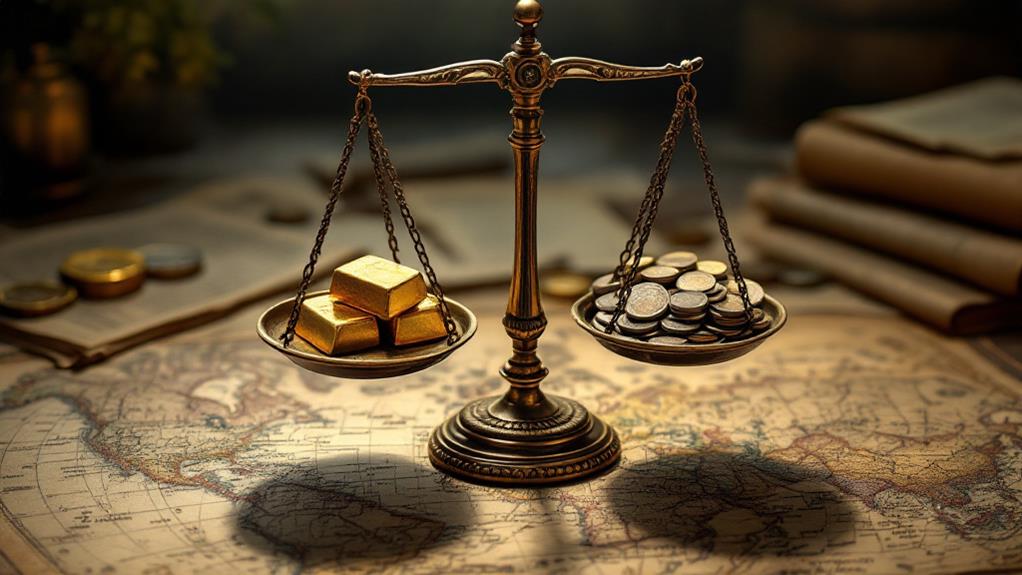
The concept of the gold standard once formed the backbone of international economic systems, linking the value of currency directly to a specific amount of gold. This system facilitated international trade and provided a sense of economic stability. By the 19th century, many countries adopted the gold standard, making it a cornerstone of global economics. Despite its historical significance, the gold standard faced challenges, especially during the Great Depression, when economic turmoil prompted some nations to abandon it.
In 1944, the Bretton Woods System sought to re-establish economic stability after World War II by pegging the U.S. dollar to gold at $35 per troy ounce, while other currencies were fixed to the dollar. However, in 1971, the U.S. moved away from this system, embracing fiat currency, which is not backed by physical commodities.
Here are some key points about the historical gold standards:
- Economic Stability: Guaranteed stable exchange rates, benefiting international trade.
- Currency Benchmark: Provided a universal benchmark for evaluating currency values.
- Bretton Woods System: Attempted to stabilize global economics post-WWII.
- Fiat Currency Shift: Marked a change away from gold reliance, altering global financial systems.
Understanding the gold standard's rise and fall offers insight into the evolution of modern economic systems.
Diverse Applications of Gold
Gold isn't just a shiny metal for adornment; it's a powerhouse in numerous industries thanks to its unique properties. One of the most interesting facts about gold is its crucial role in electronics. Gold is used in devices like smartphones and computers due to its excellent conductivity and resistance to corrosion. This guarantees reliability and longevity in connectors and circuit boards. And did you know that the aerospace industry counts on gold's reflective properties? Much gold is used in satellite components and thermal blankets to protect spacecraft from harmful radiation.
When it comes to aesthetics, approximately 80% of the mined gold annually goes into gold jewelry. This reflects the cultural significance and beauty that physical gold holds across diverse societies. Beyond adornment, gold has surprising medical applications. Gold compounds are used to treat conditions like rheumatoid arthritis and tuberculosis, showcasing its therapeutic potential. Gold nanoparticles also highlight gold's creative edge, playing a crucial role in advanced medical diagnostics, from pregnancy tests to monitoring HIV progression.
Understanding Gold Purity
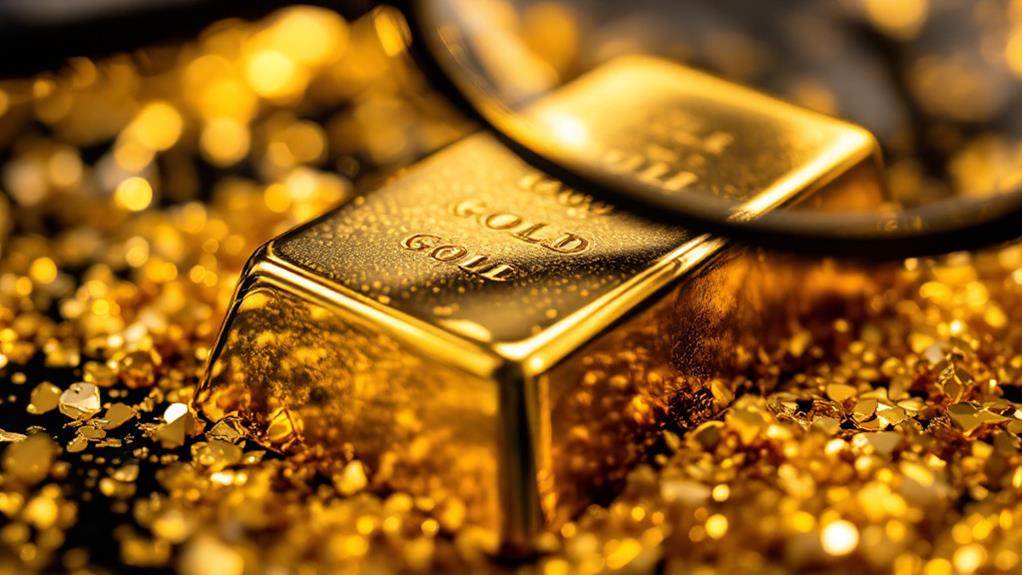
When you're exploring the world of gold jewelry, understanding gold purity is essential. Gold purity is measured in karats, with 24K gold being the pinnacle at 99.99% purity. Its unmatched luster makes it highly valued, but it's also soft, which can affect durability. Hence, 24K gold is less common in jewelry that's worn daily. Instead, lower karat gold is often preferred due to its balance between beauty and strength.
Here's what you should know about different gold purities:
- 24K Gold: Purest form with 99.99% purity; stunning but soft.
- 18K Gold: Contains 75% gold; a balance of purity and durability.
- 14K Gold: Made up of 58.3% gold, often alloyed with metals like copper for improved strength.
- Alloys: Mixing gold with other metals boosts durability, making it suitable for everyday wear.
The purity of gold directly impacts its market price and longevity. Higher karat values mean greater purity, which increases both value and potential for wear. If you're buying or investing, understanding these factors helps guarantee you make informed decisions. Regardless of whether you prioritize the brilliance of 24K gold or the resilience of 14K gold, knowing the differences is key.


